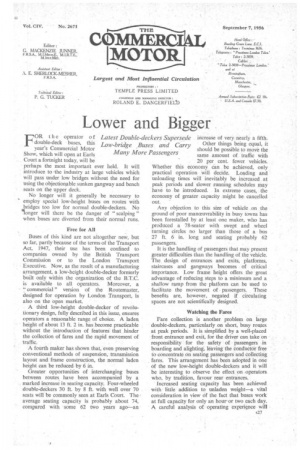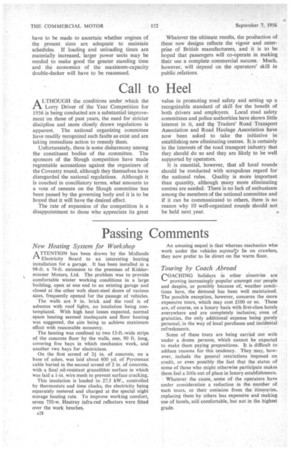Lower and Bigger
Page 29

Page 30

If you've noticed an error in this article please click here to report it so we can fix it.
FOR t h e operator o f double-deck buses, this year's Commercial Motor Show, which will open at Earls Court a fortnight today, will be perhaps the most important ever held. It will introduce to the industry at large vehicles which will pass under low bridges without the need for using the objectionable sunken gangway and bench seats on the upper deck.
No longer will it generally be necessary to employ special low-height buses on routes with bridges too low for normal double-deckers. No 'longer will there be the danger of " scalping " when buses are diverted from their normal runs.
Free for All Buses of this kind are not altogether new, but so far, partly because of the terms of the Transport Act, 1947, their use has been confined to companies owned by the British Transport Commission or to the London Transport Executive. Now, as the result of a manufacturing arrangement, a low-height double-decker formerly built only within the organization of the B.T.C. is available to all operators. Moreover, a " commercial " version of the Routenaaster, designed for operation by London Transport, is also on the open market.
A third low-height double-decker of revolutionary design, fully described in this issue, ensures operators a reasonable range of choice. A laden height of about 13 ft. 2 in. has become practicable without the introduction of features that hinder the collection of fares and the rapid movement of -traffic.
A fourth maker has shown that, even preserving conventional methods of suspension, transmission layout and frame construction, the normal laden height can be reduced by 6 in.
Greater opportunities of interchanging buses between routes have been accompanied by a marked increase in seating capacity. Four-wheeled double-deckers 30 ft. by 8 ft. with well over 70 seats will be commonly seen at Earls Court. The average seating capacity is probably about 74, compared with some 62 two years ago—an increase of very nearly a fifth.
Other things being equal, it should be possible to move the same amount of traffic with 20 per cent. fewer vehicles. Whether this economy can be achieved, only practical operation will decide. Loading and unloading times will inevitably be increased at peak periods and slower running schedules may have to be introduced. In extreme cases, the economy of greater capacity might be cancelled out.
Any objection to this size of vehicle on the ground of poor manceuvrability in busy towns has been forestalled by at least one maker, who has produced a 78-seater with swept and wheel turning circles no larger than those of a bus 27 ft. 6 in. long and seating probably 62 passengers.
It is the handling of passengers that may present greater difficulties than the handling of the vehicle. The design of entrances and exits, platforms, staircases and gangways becomes of critical importance. Low frame height offers the great advantage of reducing steps to a minimum and a shallow ramp from the platform can be used to facilitate the movement of passengers. These benefits are, however, negated if circulating spaces are not scientifically designed.
Watching the Fares Fare collection is another problem on large double-deckers, particularly on short, busy mattes at peak periods. It is simplified by a well-placed front entrance and exit, for the driver can take on responsibility for the safety of passengers in boarding and alighting, leaving the conductor free to concentrate on seating passengers and collecting fares. This arrangement has been adopted in one of the new low-height double-deckers and it will be interesting to observe the effect on operators who, by tradition, favour rear entrances.
Increased seating capacity has been achieved with little addition to unladen weight—a vital consideration in view of the fact that buses work at full capacity for only an hoar or two each day. A careful analysis of operating experience will have to be made to ascertain whether engines of the present sizes are adequate to maintain schedules. If loading and unloading times are materially increased, larger power units may be needed to make good the greater standing time and the economics of the maximum-capacity double-decker will have to be reassessed. Whatever the ultimate results, the production of these new designs reflects the vigour and enterprise of British manufacturers, and it is to be hoped that passengers will co-operate in making their use a complete commercial success. Much, however, will depend on the operators' skill in public relations.








































































































